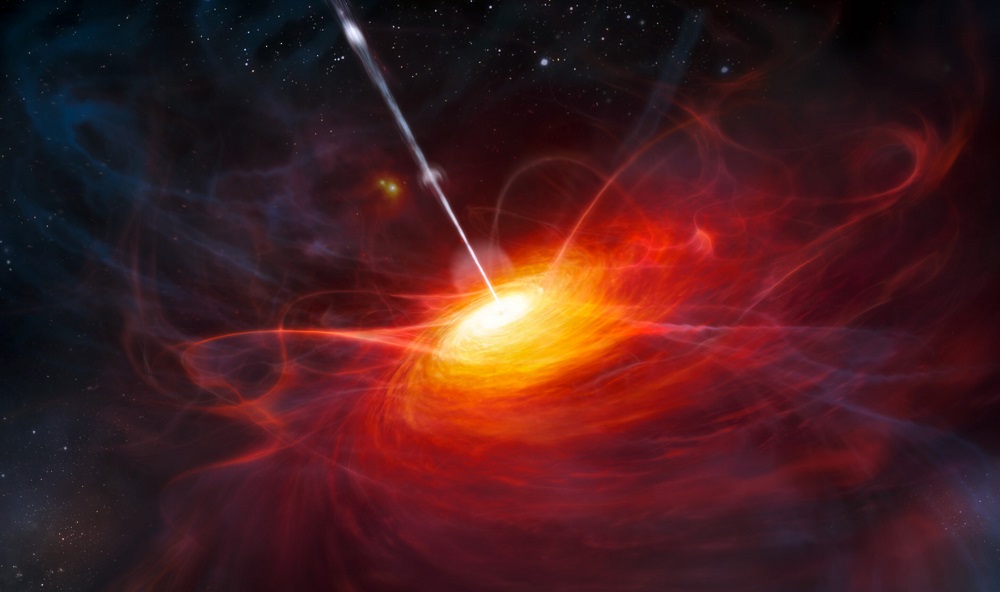Researchers from the University of Michigan and the University of Hawaii Institute of Astronomy proposed an optical method that uses the light from quasars to determine the rate of the universe’s expansion. The method, the researchers said, is more direct than previous approaches. Quasars have been used in this manner before; however, the new method, called intensity correlation speckles, measures the difference between the red shift in two paths of light from the same quasar.
Red shift occurs as light stretches as it travels through an expanding universe, causing its wavelength to elongate.
When a massive galaxy cluster lies between Earth and a given quasar, light from the same quasar can travel directly to us, or it can bend around the galaxy cluster due to the cluster’s gravity. Light that bends around a cluster can arrive up to 100 years after light that travels to Earth in a straight line, which can cause a quasar to become “strongly lensed.” This means that what may look like four quasars is actually just a single quasar whose light is refracted by the galaxy cluster’s gravitational pull.

Artist’s rendering of the accretion disk in ULAS J1120+0641, a very distant quasar powered by a supermassive black hole with a mass 2 billion times that of the sun. Courtesy of ESO/M. Kornmesser.
In theory, physicists could measure the redshift of the light that travels in a curved path to Earth from a single quasar and compare it to the redshift of the light that travels to Earth in a different path. However, while time delay has been determined for a small number of quasars by measuring the time variation in their colors, directly measuring the tiny redshift between the two paths, corresponding to a small expansion of the universe during a decade or so, has not been possible.
“The redshift of these different images are delayed, and in that delay, the universe has expanded. Measuring this can’t be done with ordinary spectrographs, where you measure the wavelength of the light very accurately for two closely spaced lines,” University of Michigan physicist Gregory Tarlé said. “The reason that can’t be done is because the light source contains all sorts of atoms that are moving randomly and emitting radiation that is Doppler shifted.”
This collection of Doppler shifts, called Doppler broadening, causes light frequencies to spread out within the same image to the extent that it is difficult to make an accurate measurement of the average redshift of one quasar image.

“The project came out of an idea I had for a while, which is to measure the expansion of the universe directly. The problem is that we have no spectrograph that could measure the small redshift of the universe that happens in 100 years,” University of Hawaii cosmology theorist Istvan Szapudi said. “Such a measurement would directly tell us how much the universe expanded in 10 years, eventually determining the Hubble constant, the present holy grail of cosmology.”
Tarlé and Szapudi approached University of Michigan optical physicist Roberto Merlin, who suggested a method from optical physics called intensity correlation. That method takes into account the collection of frequencies of this Doppler-broadened light and compresses the frequencies into an average line.
Tarlé compared the process to to the harmony one hears when two tuning forks are hit at the same time. The Doppler effect itself is often described as what an ambulance sounds like as it passes by; Merlin mores specifically compared his method to a group of ambulances traveling north and a group of ambulances traveling south. In the cacophony of sound produced by the ambulances, a single thrumming note would come through.
Applying the approach to light from quasars, the light that bends to Earth along one path has one average frequency, and the light bending along another path has another average frequency. Merlin’s method measures the difference between the two to determine the acceleration of the quasar.
“Our effect takes advantage of the fact that Doppler and other forms of broadening have little effect on the relative difference between the colors of light emitted by the atoms if the unbroadened colors are very similar,” University of Michigan graduate student and co-author Noah Green said. “It’s as if our ambulances each have two klaxons playing pitches that are musically very close together, and out of the cacophony we can figure out how far apart those pitches are.”
In principle, the researchers said, if they can measure the acceleration of many hundreds of quasars at different redshifts, they can measure the acceleration of the universe.
The next step to test the theory, Tarlé said, would be to develop instrumentation that could be integrated with large ground-based telescopes. The instrument would precisely measure the arrival time of photons emitted by strongly lensed quasars so that physicists could determine the redshift.
“And so if we could do that then we could not only measure the Hubble constant directly as a function of the redshift, we could also measure the impact of dark energy on the acceleration of the universe,” Tarlé said. “This is why this is so exciting.”
The research was published in Physical Review A (www.doi.org/10.1103/PhysRevA.103.L041701).